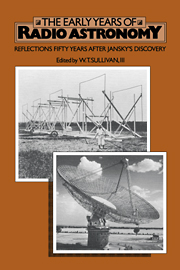Book contents
- Frontmatter
- Contents
- Preface
- THE EARLIEST YEARS
- AUSTRALIA
- ENGLAND
- THE REST OF THE WORLD
- The first steps of Soviet radio astronomy
- Remarks on my work in radio astronomy
- The early years of radio astronomy in France
- Beginnings of solar radio astronomy in Canada
- Development of solar radio astronomy in Japan up until 1960
- BROADER REFLECTIONS
- Biographical notes on contributors
- Name index
- Subject index
Development of solar radio astronomy in Japan up until 1960
Published online by Cambridge University Press: 05 March 2010
- Frontmatter
- Contents
- Preface
- THE EARLIEST YEARS
- AUSTRALIA
- ENGLAND
- THE REST OF THE WORLD
- The first steps of Soviet radio astronomy
- Remarks on my work in radio astronomy
- The early years of radio astronomy in France
- Beginnings of solar radio astronomy in Canada
- Development of solar radio astronomy in Japan up until 1960
- BROADER REFLECTIONS
- Biographical notes on contributors
- Name index
- Subject index
Summary
The start of radio astronomy in Japan was about four years behind the rest of the world. However, considering the difficult social circumstances arising from the nation's defeat in World War II, its development was not so slow. We were hungry, few materials were available, and the general power supply was desperately unstable — frequency fluctuated between 54 and 61 Hz, and the voltage between 85 and 105 V, even in 1950. My first work was therefore the design of an A.C. voltage stabilizer of 0.1 % accuracy, and I believe it greatly supported the development of observing facilities in Japan.
In this article, I will first introduce three topics of early Japanese research which have seldom been discussed, even in Japan. Then, I will briefly review how solar radio astronomy developed in Japan in those early days. A precise review of scientific studies on radio astronomy in Japan until 1962 was made in Chapter 5 of ‘Progress in Radio Science in Japan’, September 1963, which was distributed at the General Assembly of URSI held in Tokyo.
TOPICS NOT WELL KNOWN
Solar radio noise was recognized in 1938 in Japan
Arakawa (1936) and Dellinger (1937) had reported that a kind of ‘grinder’ like noise sometimes appeared almost simultaneously with Dellinger phenomena in short-wave telecommunication receivers. Dellinger phenomenon is the phenomenon of sudden decrease or fade-out of long distance telecommunication radio waves due to ionospheric disturbances caused by solar flares. Nakagami & Miya (1939), of the International Telecommunication Co. Ltd., Tokyo, were interested in the origin of that temporary noise, and therefore tried to measure its incident angle, together with that of communication signals.
- Type
- Chapter
- Information
- The Early Years of Radio AstronomyReflections Fifty Years after Jansky's Discovery, pp. 335 - 348Publisher: Cambridge University PressPrint publication year: 1984
- 6
- Cited by



